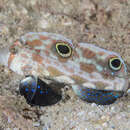pms
nòm ant ël fil


Signigobius biocellatus és una espècie de peix de la família dels gòbids i de l'ordre dels perciformes.
Menja invertebrats.[3]
És un peix marí, de clima tropical (22°C-27°C)[7] i associat als esculls de corall que viu entre 1-30 m de fondària.[8][3]
Es troba al Pacífic occidental: des de les Filipines fins a Salomó, Vanuatu, el sud de la Gran Barrera de Corall i Palau (la Micronèsia).[3][9][10][11][12][13][14][15][16][17][18][19]
És inofensiu per als humans.[3]
Signigobius biocellatus és una espècie de peix de la família dels gòbids i de l'ordre dels perciformes.
The Twin-spot Goby, or Crab-eyed Goby, (Signigobius biocellatus)[1] is a species of goby native to the Western Pacific Ocean where they can be found in areas of sand, silt in lagoons, or coastal bays with nearby cover such as rubble, coral, or leaf litter. They can be found at depths of from 1 to 30 metres (3.3 to 98.4 ft). This species can reach a length of 10 centimetres (3.9 in) SL. It can also be found in the aquarium trade. It is currently the only known member of its genus.[2]
The Twin-spot Goby, or Crab-eyed Goby, (Signigobius biocellatus) is a species of goby native to the Western Pacific Ocean where they can be found in areas of sand, silt in lagoons, or coastal bays with nearby cover such as rubble, coral, or leaf litter. They can be found at depths of from 1 to 30 metres (3.3 to 98.4 ft). This species can reach a length of 10 centimetres (3.9 in) SL. It can also be found in the aquarium trade. It is currently the only known member of its genus.
Signigobius biocellatus es una especie de peces de la familia de los Gobiidae en el orden de los Perciformes.
Los machos pueden llegar alcanzar los 10 cm de longitud total.[1][2]
Es monógamo.
Come invertebrados.
Es un pez de mar y, de clima tropical (22 °C-27 °C).
Se encuentra en el Pacífico occidental: desde las Filipinas hasta las Islas Salomón, Vanuatu, el sur de la Gran Barrera de Coral y República de Palacio (la Micronesia ).
Es inofensivo para los humanos.
Signigobius biocellatus es una especie de peces de la familia de los Gobiidae en el orden de los Perciformes.
Signigobius biocellatus Signigobius generoko animalia da. Arrainen barruko Actinopterygii klasean sailkatzen da, Gobiidae familian.
Signigobius biocellatus Signigobius generoko animalia da. Arrainen barruko Actinopterygii klasean sailkatzen da, Gobiidae familian.
Rengasevätokko (Signigobius biocellatus) on tokkoihin kuuluva kala. Se on sukunsa ainut laji.
Rengasevätokko kasvaa noin seitsemän senttiä pitkäksi. Sen yleisväri on harmaanruskean kirjava, selkäevässä on kaksi silmäkuviota. [1]
Rengasevätokko elää luonnossa Tyynenmeren länsiosissa.[2]
Rengasevätokko kaivelee ruokaa pohjahiekan seasta. Se elää yleensä pareittain.[3]
Rengasevätokkoa on vaikea opettaa syömään korvikeruokaa: se haluaa pyydystää itse ruokansa pohjahiekan seasta. Niinpä altaassa on hyvä olla elävää kiveä, jossa erilaiset madot ja pienet katkaravut voivat lisääntyä. Tarjottavan valmisruoan on oltava lihapitoista: mielellään eläviä matoja, massiäyriäisiä, Artemia-äyriäisiä ja muuta pakasteruokaa.[4]
Signigobius biocellatus
Le Gobie à deux ocelles ou Gobie aux yeux de crabe (Signigobius biocellatus) est une espèce de poissons marins appartenant à la grande famille des Gobiidés. C'est l'unique espèce de son genre Signigobius.
Signigobius biocellatus
Le Gobie à deux ocelles ou Gobie aux yeux de crabe (Signigobius biocellatus) est une espèce de poissons marins appartenant à la grande famille des Gobiidés. C'est l'unique espèce de son genre Signigobius.
Signigobius biocellatus è l'unica specie del genere Signigobius, appartenente alla famiglia Gobiidae.
Questa specie è diffusa nelPacifico occidentale, nelle acque costiere e al largo dell'Australia (Grande Barriera Corallina), Indonesia, Papua Nuova Guinea, Filippine, Isole Salomone. Abita fondali mobili, sabbiosi o detritici, nelle lagune degli atolli e coralline.
Presenta un corpo tozzo, di colore argenteo-verdastro, chiazzato in bruno più o meno chiaro. Caratteristica la doppia pinna dorsale, con due grossi ocelli neri cerchiati in giallo e nero, uno per parte, da cui deriva il nome biocellatus. La pinna anale è bruno-nera, puntinata in azzurro chiaro.
Raggiunge una lunghezza di 10 cm.
È specie monogama: le coppie producono un nido dove verranno deposte le uova.
Si nutre di invertebrati scovati nella sabbia.
Signigobius biocellatus è l'unica specie del genere Signigobius, appartenente alla famiglia Gobiidae.
Signigobius biocellatus is een straalvinnige vissensoort uit de familie van grondels (Gobiidae).[1] De wetenschappelijke naam van de soort is voor het eerst geldig gepubliceerd in 1977 door Hoese & Allen.
Bronnen, noten en/of referentiesSignigobius biocellatus – gatunek ryby z rodziny babkowatych (Gobiidae).
Zachodni Pacyfik od Filipin po Vanuatu oraz na południe po południową część Wielkiej Rafy Koralowej.
Występuje w piaszczystych bądź mulistych lagunach i zatokach na głębokości 2(1)–30 m, w pobliżu korali, kamieni, bądź części roślin dających schronienie. Żyje w wodach o temp 22–27 °C.
Osiąga do 10 cm długości. Na pierwszym łuku skrzelowym 10 wyrostków filtracyjnych, 4 na górnej i 6 na dolnej części. W płetwach grzbietowych 7 twardych i 10–11 miękkich promieni, w płetwie odbytowej 1 twardy i 10–11 miękkich promieni. W płetwach piersiowych 20–22 promienie.
Na płetwach grzbietowych wyraźne okrągłe plamki.
Żywi się niewielkimi bezkręgowcami odfiltrowywanymi z piasku.
Hodowana w akwariach.
Signigobius biocellatus – gatunek ryby z rodziny babkowatych (Gobiidae).